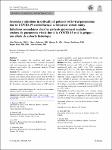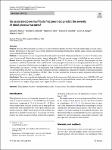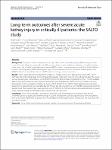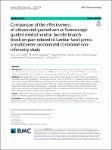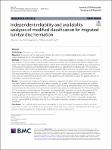Search
Author
- Daqing, Ma (3)
- Alexis, Ferré (2)
- Anna, Lybeck (2)
- Ashish K., Khanna (2)
- next >
Subject
- intensive care unit (8)
- acute respiratory dist... (5)
- chronic obstructive pu... (5)
- ICU (5)
- next >
Date issued
Has File(s)
Search Results
Secondary infections were common among critically ill patients with viral pneumonia including COVID-19. We found no difference in the incidence of SI between COVID-19 and influenza in our cohort study, but SI in patients with COVID-19 were associated with worse clinical outcomes and increased healthcare resource use. The small cohort size precludes any causal inferences but may provide a basis for future research. |
Latent tuberculosis (TB) infection has been known as a seedbed for TB disease later in life. The interruption from latent TB infection to TB disease can be done through TB preventive treatment (TPT). In Cambodia, only 40.0% of children under five years old who were the household contacts to bacteriologically confirmed TB cases were initiated with TPT in 2021. Scientific studies of context-specific operational challenges in TPT provision and uptake among children are scarce, particularly in high TB-burden countries. This study identified challenges in TPT provision and uptake among children in Cambodia from the perspective of healthcare providers and caregivers. |
The implications of an associated proximal fibula fracture in the setting of tibial plateau fractures has been examined in several reports [1, 5, 12, 14, 16]; however, there is a paucity of the literature describing their relationship to fracture classification and injury characteristics. This study aims to enhance our understanding of tibial plateau fractures and their relationship to proximal fibula fractures and meniscal injuries, to improve diagnosis, preoperative planning, and post-operative outcomes in these patients. |
With the surge of critically ill COVID-19 patients in China, numerous anesthesiologists from anesthesia intensive care units (AICU) or reallocated to other ICUs were devoted to the treatment of COVID-19. Besides the standard protocols to treat COVID-19 cases, anesthesiologists also have their own experience to treat COVID-19 cases based on professional expertise and practice. Here, we propose some viewpoints to treat critically ill COIVD-19 patients from the perspective of anesthesiologists. |
Univariate and multivariate analysis with Cox model were used to identify risk factors associated with long-term mortality. Variables with p < 0.1 in the univariate analysis as well as those that are clinically important like severity, age and some comorbidities were included in the model. Schoenfeld residuals are presented in the supplementary appendix (Additional file 1: Figure S3) to check the proportional hazards assumption. We analyzed risk factors associated with the occurrence of WRF. In this context, we tested variables which have been reported to be potentially associated with worse renal outcomes (CKD, CCF, diabetes, age, hypertension, severity scores) [23]. We also assessed a potential association between RRT initiation strategy and WRF. |
Osteoarthritis (OA) is a chronic joint disease characterized by degenerative articular cartilage changes and secondary hyperosteogeny [1], affecting 10–15% of adults over the age of 60 worldwide [2]. OA is a major cause of disability, and its incidence, which is related to sex, age, obesity, joint trauma, and other factors, is on the rise, bringing a huge economic burden to patients and society [3, 4]. The pathogenesis of OA involves a redox state imbalance leading to oxidative stress, aging, and apoptosis in chondrocytes, as well as decreased anabolism and increased catabolism of the extracellular matrix [5, 6]. After articular cartilage injury, it is mainly repaired by the proliferation and differentiation of chondrocytes. However, the proliferative capacity of chondrocytes is lim... |
Lumbar facet joints (LFJ) syndrome is a common source of spinal suffering affecting up to 45% of patients with a chronic low back pain (LBP) because of inflammation, degenerative or arthritic changes, overload of the posterior LFJ or muscle imbalance [1,2,3,4,5,6]. It can be defined as a lumbosacral pain sometimes associated with sciatic pain that spread from any structure of facet/zygapophyseal joints [1,2,3,4,5,6]. Despite the high prevalence and the annual cost that it can generates, this syndrome is always difficult for pain doctors to take care of [5]. |
In this study, the incidence of migrated lumbar disc herniation was about 10.5%, and most of the patients were male. Patients with higher BMI are more likely to develop this disease. Our study confirmed that the modified classification has moderate to high confidence. During the 2-year follow-up period, 66 patients (62.9%) were treated conservatively, and the patients with conservative treatment were mainly A2 and B2 type (59.1%). Thirty-nine patients (37.1%) underwent surgical treatment. The patients recovered well after operation, and the low back pain and ODI index were significantly improved at 1 year after operation (P < 0.05). We suggest that type A1 and B1 migrated nucleus pulposus can be removed by posterior approach. For type A2, B2, C1, C2, the lateral approach is recommen... |
To provide an expert commentary on the impact of prior COVID-19 infection on patient’s surgical outcomes and postoperative recovery. To highlight the need for greater focus on peri-operative care of patients who have recovered from COVID-19. |
The telemedicine intensive care unit (Tele-ICU) is defined as a system in which intensive care professionals remotely provide care to critically ill patients and support the on-site staff in the intensive care unit (ICU) using secured audio–video and electronic links. Although the Tele-ICU is expected to resolve the shortage of intensivists and reduce the regional disparities in intensive care resources, the efficacy has not yet been evaluated in Japan because of a lack of clinically available system. |

